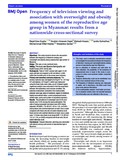| dc.contributor.author | Gupta, Rajat Das | |
| dc.contributor.author | Sajal, Ibrahim Hossain | |
| dc.contributor.author | Hasan, Mehedi | |
| dc.contributor.author | Sutradhar, Ipsita | |
| dc.contributor.author | Haider, Mohammad Rifat | |
| dc.contributor.author | Sarker, Malabika | |
| dc.date.accessioned | 2022-03-16T09:41:37Z | |
| dc.date.available | 2022-03-16T09:41:37Z | |
| dc.date.copyright | 2019 | |
| dc.date.issued | 2019-03-20 | |
| dc.identifier.citation | Das Gupta, R., Sajal, I. H., Hasan, M., Sutradhar, I., Haider, M. R., & Sarker, M. (2019). Frequency of television viewing and association with overweight and obesity among women of the reproductive age group in Myanmar: Results from a nationwide cross-sectional survey. BMJ Open, 9(3) doi:10.1136/bmjopen-2018-024680 | en_US |
| dc.identifier.uri | http://hdl.handle.net/10361/16469 | |
| dc.description | This article was published in the BMJ Open [© Author(s) (or their employer(s)) 2019. Re-use permitted under CC BY. Published by BMJ. ] and the definite version is available at: http://dx.doi.org/10.1136/bmjopen-2018-024680
The Journal's website is at: https://bmjopen.bmj.com/content/9/3/e024680.full | en_US |
| dc.description.abstract | Objectives This study aimed to discern the association between the frequency of television viewing and overweight and obesity among reproductive age women of Myanmar.
Design This was a cross-sectional study.
Setting This study used Myanmar Demographic and Health Survey (2015–2016) data.
Participants Total of 12 021 women both aged 15–49 years and also not pregnant or did not deliver a child within the 2 months prior to the survey were included.
Primary and secondary outcome measures The primary outcome was overweight (23.0 kg/m2 to <27.5 kg/m2) and obesity (≥27.5 kg/m2), which was measured using the Asian body mass index cut-off. Ordered logistic regression analysis was conducted to find the association between the explanatory and outcome variables. The potential confounders controlled in the multivariable analyses were age, place of residence, region of residence, highest educational status, current employment status, wealth index, parity and number of household members.
Results The prevalence of overweight was 26.5% and obesity was 12.2% among the study participants. The odds of being overweight and obese were 20% higher (adjusted OR (AOR) 1.16, 95% CI 1.02 to 1.32; p=0.023) among those who watched television at least once a week compared with those who did not watch television at all. Rural women who watched television at least once a week were 1.2 times more likely to be obese (AOR 1.16, 95% CI 1.01 to 1.34; p=0.040) compared with those who did not watch television at all.
Conclusions Frequent television watching was associated with obesity among rural women of reproductive age in Myanmar.
This is an open access article distributed in accordance with the Creative Commons Attribution Non Commercial (CC BY-NC 4.0) license, which permits others to distribute, remix, adapt, build upon this work non-commercially, and license their derivative works on different terms, provided the original work is properly cited, appropriate credit is given, any changes made indicated, and the use is non-commercial. | en_US |
| dc.language.iso | en_US | en_US |
| dc.publisher | BMJ Open | en_US |
| dc.relation.uri | https://bmjopen.bmj.com/content/9/3/e024680.full | |
| dc.subject | Myanmar | en_US |
| dc.subject | Non-Communicable Disease | en_US |
| dc.subject | Obesity | en_US |
| dc.subject | Overweight | en_US |
| dc.title | Frequency of television viewing and association with overweight and obesity among women of the reproductive age group in Myanmar: Results from a nationwide cross-sectional survey | en_US |
| dc.type | Journal Article | en_US |
| dc.description.version | Published | |
| dc.contributor.department | Brac James P. Grant School of Public Health | |
| dc.identifier.doi | http://dx.doi.org/10.1136/bmjopen-2018-024680 | |

